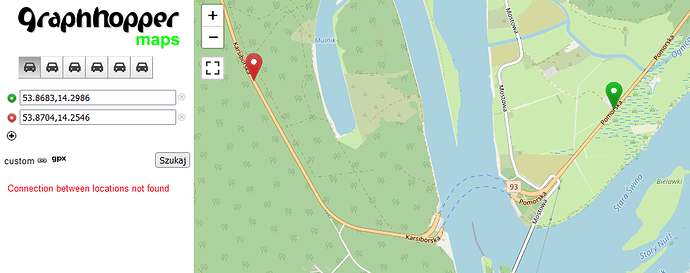Hi,
I am trying to run my own server on GH 6.2 with Poland map on OSM. Everything is working OK, except ferry route (Connection between locations not found).
I checked that route on OSM map, and it is working ok, so probably I have to change something in mine configuration.
Example of route (working on OSM) OpenStreetMap
The same route on mine server:
My config file:
{
"graphhopper": {
"datareader.file": "",
"graph.location": "graph-cache",
"graph.dataaccess": "RAM_STORE",
"graph.vehicles": "car,roads|transportation_mode=HGV",
"graph.encoded_values":"hgv,max_axle_load,max_height,max_length,max_speed,max_weight,max_width,road_access,road_class,road_class_link,road_environment,surface,toll",
"profiles": [
...
],
"profiles_ch": [
...
],
"profiles_lm": [],
"prepare.ch.threads": 14,
"prepare.lm.threads": 14,
"prepare.min_network_size": 200,
"routing.max_visited_nodes": 50000000,
"routing.non_ch.max_waypoint_distance": 4000000,
"index.max_region_search": 8,
"datareader.preferred_language": "pl",
"import.osm.ignored_highways": "footway,cycleway,path,pedestrian,steps"
},
"server": {
"application_connectors": [
{
"type": "http",
"port": 80,
"bind_host": "localhost"
}
],
"request_log": {
"appenders": []
},
"admin_connectors": [
{
"type": "http",
"port": 8990,
"bind_host": "localhost"
}
]
},
custom car profile is only with distance_influence:
{
"distance_influence": 0
}
What should I add or change, to get it working?


